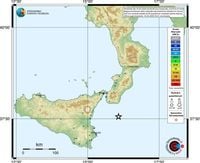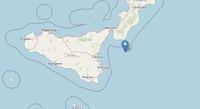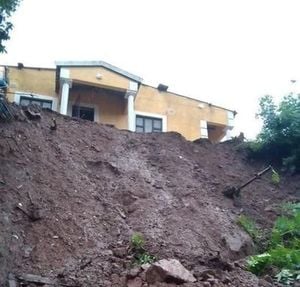A strong earthquake struck the regions of Calabria and Sicily early on April 16, 2025, at 3:26 AM, sending shockwaves that startled residents awake. The earthquake, recorded at a magnitude of 4.8 by the National Institute of Geophysics and Volcanology (INGV), had its epicenter in the Southern Ionian Sea, situated at a depth of 48 kilometers. Reports indicated that the tremor was felt most acutely in cities including Catania, Reggio Calabria, Messina, Ragusa, Siracusa, Modica, Augusta, Acireale, Avola, and Noto.
Despite the intensity of the quake, there have been no reports of injuries or damage to property. The earthquake's suddenness caught many residents off guard, leading to a night of fear and confusion. In Ragusa, Modica, Augusta, Lentini, and Caltagirone, the local fire brigade received numerous calls from residents seeking information and reassurance about the seismic event.
Social media platforms lit up with comments and reactions as people shared their experiences of the earthquake. Users flooded Instagram and Facebook with posts detailing their feelings and observations during the tremor, reflecting a collective anxiety that accompanied the event. The seismic activity prompted seismologists to closely monitor the situation, assessing the potential for aftershocks or seismic swarms.
The geological dynamics of the Ionian Sea contribute to such earthquakes, primarily due to the complex interactions between the African Plate and the Eurasian Plate. This collision and subduction process generates significant stress within the Earth's crust. When this stress exceeds the strength of the rocks, it releases energy in the form of seismic waves, resulting in earthquakes.
Active fault systems in the region, such as the Alfeo fault system, further heighten the seismic risk. These geological features are instrumental in understanding the patterns of earthquake occurrences in the Ionian Sea.
The earthquake on April 16 serves as a reminder of the region's vulnerability to seismic activity. Historical records indicate that the Ionian Sea has been the site of numerous earthquakes over the years, with varying magnitudes and impacts on local communities.
In the wake of the earthquake, emergency services and local authorities are on high alert, prepared to respond to any potential aftereffects. The quick response from the fire brigade and the influx of calls for information underscore the importance of public awareness and preparedness in the face of natural disasters.
As the situation develops, residents are encouraged to stay informed through official channels and heed any safety advisories issued by local authorities. The community's resilience and preparedness will play a crucial role in navigating the aftermath of this seismic event.
In summary, the earthquake felt across Calabria and Sicily on April 16, 2025, was a significant geological event that highlighted the region's seismic activity and the need for ongoing monitoring and preparedness. With no immediate damage reported, the focus now shifts to understanding the implications of this earthquake and ensuring the safety of the population in the days to come.





